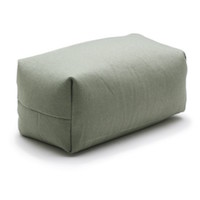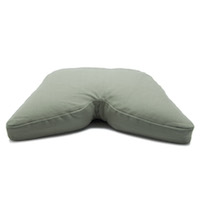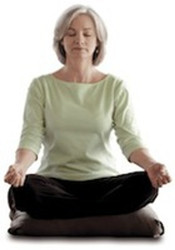Knee and Hip Pain During Sitting Meditation
Posted by Jay Suthers on Mar 11th, 2016
I oftentimes hear from customers seeking a solution to knee and hip discomfort during sitting meditation. After making a brief disclaimer that I am not a medical professional, I most frequently begin a discussion on various ways to support the joints so as to relieve weight-bearing strain on them.
The knee is a compound joint that offers a large range of motion in bending the lower leg backward and limited range of motion in any other direction - forward, side-to-side, or twisting. In fact, the rotation of the leg to an outward position in the cross-legged or lotus sitting posture is accomplished by the hip joint and not the knee joint.
 Knee discomfort generally arises from the joint being twisted as gravity pulls the leg down toward the ground. The discomfort may not be the joint itself so much as all the connective tissue and cartilage around the joint. Exercise and age can cause these components to become less flexible. It is also more likely that with age we may have experienced some trauma or injury to the knee joint that can induce more pain when it is stressed.
Knee discomfort generally arises from the joint being twisted as gravity pulls the leg down toward the ground. The discomfort may not be the joint itself so much as all the connective tissue and cartilage around the joint. Exercise and age can cause these components to become less flexible. It is also more likely that with age we may have experienced some trauma or injury to the knee joint that can induce more pain when it is stressed.
Likewise, hip discomfort can arise from the rotation and open position of the joint. For men especially, hamstring muscles on the back of the leg become “short” and make it difficult to get the knees down during sitting meditation. This tends to pull and strain the hip joint. Again, as we age, the joint can become less flexible due to calcification and reduced fluid production, oftentimes a result of osteoarthritis.
That is pretty much the limit of my medical knowledge on these joints of the body. The solution to discomfort during meditation is three fold: support the area of discomfort, increase flexibility in the legs through yoga, massage and stretching exercises, or sit in a different posture during meditation.
 The Cosmic Cushion is by far the most supportive meditation cushion. The round Zafu or a simple rectangular bolster generally provide lift under the sit bones and leave the entire leg hanging off a cliff, so to speak. The Cosmic Cushion provides support over a much broader area because one sits fully on top of this cushion.
The Cosmic Cushion is by far the most supportive meditation cushion. The round Zafu or a simple rectangular bolster generally provide lift under the sit bones and leave the entire leg hanging off a cliff, so to speak. The Cosmic Cushion provides support over a much broader area because one sits fully on top of this cushion.
Knee Pillows and the Kapok Support Cushion can be placed under the knees, thighs, or calves to keep the knee area raised up. This will reduce the twisting action on the knee joint and may even reduce some pressure on the ankles.
Sitting in a kneeling posture, also known as Seiza, greatly changes the dynamics of the hip and knee joints. There is no twisting action and gravity no longer pulls at the joints. Kneeling can be accomplished by straddling a Zafu or Yoga Bolster, but is best accomplished with a Meditation Bench.
Since most of the discomfort in the legs is caused by the connective tissues and muscles, improving flexibility will allow the joints to move more freely and with less discomfort. Many yoga poses are designed to stretch muscle tissues and “open” the joints. A massage therapist can soften muscle tissues and relax tendons and ligaments. Similar to yoga, many exercise trainers are knowledgable about stretching exercises that can reduce the possibility of injury during exercise. These practices can recondition the muscles and other tissues to improve joint flexibility.
Meditation is a practice of the mind and not the body. While a good sitting posture helps us to be active and mindful during meditation, any posture can be used during meditation. At some point we should achieve a level of awareness through meditation that excludes the body. Sitting in a chair or assuming shavasana (corpse or lying pose) for meditation should be no more or less effective for meditation. We should not feel as though we are failing in our meditation if we simply cannot get comfortable in the sitting posture and have to change to a more comfortable position.
Thank you for reading,
Jay
If you would like to comment on this blog or have any questions, please feel free to Contact Sage Meditation Customer Service.

